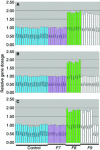Hemophilia B: molecular pathogenesis and mutation analysis
- PMID: 25851415
- PMCID: PMC4496316
- DOI: 10.1111/jth.12958
Hemophilia B: molecular pathogenesis and mutation analysis
Abstract
Hemophilia B is an X-chromosome-linked inherited bleeding disorder primarily affecting males, but those carrier females with reduced factor IX activity (FIX:C) levels may also experience some bleeding. Genetic analysis has been undertaken for hemophilia B since the mid-1980s, through linkage analysis to track inheritance of an affected allele, and to enable determination of the familial mutation. Mutation analysis using PCR and Sanger sequencing along with dosage analysis for detection of large deletions/duplications enables mutation detection in > 97% of patients with hemophilia B. The risk of the development of inhibitory antibodies, which are reported in ~ 2% of patients with hemophilia B, can be predicted, especially in patients with large deletions, and these individuals are also at risk of anaphylaxis, and nephrotic syndrome if they receive immune tolerance induction. Inhibitors also occur in patients with nonsense mutations, occasionally in patients with small insertions/deletions or splice mutations, and rarely in patients with missense mutations (p.Gln237Lys and p.Gln241His). Hemophilia B results from several different mechanisms, and those associated with hemophilia B Leyden, ribosome readthrough of nonsense mutations and apparently 'silent' changes that do not alter amino acid coding are explored. Large databases of genetic variants in healthy individuals and patients with a range of disorders, including hemophilia B, are yielding useful information on sequence variant frequency to help establish possible variant pathogenicity, and a growing range of algorithms are available to help predict pathogenicity for previously unreported variants.
Keywords: DNA Mutational Analysis; factor IX; genetic carrier detection; hemophilia B; prenatal diagnosis.
© 2015 The Authors. Journal of Thrombosis and Haemostasis published by Wiley Periodicals, Inc. on behalf of International Society on Thrombosis and Haemostasis.
Figures


References
-
- UKHCDO . UK National Haemophilia Database Bleeding Disorder Statistics for 2013–2014 http://www.ukhcdo.org/annReport.htm. Accessed 2 February 2015.
-
- Yoshitake S, Schach BG, Foster DC, Davie EW, Kurachi K. Nucleotide sequence of the gene for human factor IX (antihemophilic factor B). Biochemistry 1985; 24: 3736–50. - PubMed
-
- Stonebraker JS, Bolton‐Maggs PH, Michael Soucie J, Walker I, Brooker M. A study of variations in the reported haemophilia B prevalence around the world. Haemophilia 2012; 18: e91–4. - PubMed
Publication types
MeSH terms
Substances
Grants and funding
LinkOut - more resources
Full Text Sources
Other Literature Sources

